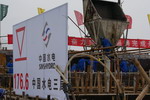China leads in carbon capture, says IEA
Updated: 2011-09-22 10:54
By Du Juan (China Daily)
|
|||||||||||
BEIJING - China is playing a leading role in applying carbon capture and storage (CCS) technologies, an initiative that the International Energy Agency (IEA) expects to help cut global carbon emissions in industrial sectors by 4 gigatons a year by 2050.
"The Chinese government is making serious efforts in CCS in both investment and technological research, which has put it ahead of many other countries," said Ellina Levina, energy analyst of the agency's CCS unit.
CCS technologies capture carbon dioxide (CO2) before or after combustion in the industries such as cement, oil and power, and store it for other uses. The IEA considers it the most effective way to cut carbon emissions.
"One goal of the IEA is to generate 100 CCS projects worldwide by the end of 2020, and we estimate that half of them will probably be in developing countries," Levina said.
China has great potential to launch more CCS projects in the next 10 years, Levina said, adding that those projects will help it meet its emission-reduction target.
China has committed to reduce its CO2 emissions by 40 to 45 percent from 2005 levels for each unit of GDP by 2020.
CCS can be profitable for China - the world's second-largest economy and a big emitter - if it develops its own technology and sells it to other countries, Levina said.
She said that she is confident in Chinese technologies for carbon capture, storage and utilization.
China Huaneng Group, one of the country's leading power companies, launched in cooperation with the Australian Commonwealth Scientific and Industrial Research Organization a CO2 capture facility in coal-fired power plants in December 2007. It was put into operation in 2008, with an annual capturing capacity of 3,000 tons.
Huaneng also has a CCS project in Shanghai with an annual capacity of 120,000 tons, and it is preparing another project with a yearly capacity of more than 1 million tons, said S. Ming Sung, chief representative of Asia-Pacific at the Clean Air Task Force, a nonprofit organization.
According to Sung, China Power Investment Corp has built a CCS facility with an annual capacity of 100,000 tons, which will soon be put into operation.
Another CCS project, Integrated Gasification Combined Cycle Power Plant, will begin operation by the end of the year in Tianjin. Shenhua Group Corp, China's largest coal miner by output, and Peabody Energy Corp, the US-based energy company, participated in the project.
Sung said Shenhua has another CCS program in Ordos, the Inner Mongolia autonomous region, which has a capacity for 10,000 tons a year.
CO2 can be refined to 99.99 percent purity and can be used to produce carbonated beverages.
"The government should take CCS projects as a major strategy for reducing carbon emissions," said Bo Diczfalusy, director of sustainable energy policy and technology at the IEA. "Thus, reducing the high cost of CCS is not only the challenge of industries, but also of governments, which will be beneficial for all in the long term."
The IEA and the United Nations Industrial Development Organization (UNIDO) estimated that by 2050, CCS has the potential to reduce carbon emissions from industrial sectors by 4 gigatons annually, accounting for about 9 percent of the global reductions needed to halve energy-related CO2 emissions by then. "The next 10 years will be crucial for CCS development," said Edward Clarence-Smith, UNIDO representative and director of the regional office in China. "While the developed world must pave the way for CCS deployment in the next decade, the technology must also spread rapidly in the developing world."
Related Stories
China supports IEA's release of oil reserves 2011-06-25 09:54
IEA believes new policy could lead to positive outlook on energy mix 2011-06-08 07:27
Reduce power waste, another path to low carbon 2011-09-18 15:19
Low-carbon growth 'needs incentives' 2011-09-16 07:46
- IHA protocol promotes sustainable hydropower
- Machinery production up 26.42% in first 8 months
- AmCham Shanghai calls for more engagement
- Govt sells low-rent housing equities to raise cash
- Citibank China expands to the west
- BRICS hint at funds to fight new debt crises
- 'Debt crises offer chances'
- Eco-cities are the key to conservation













